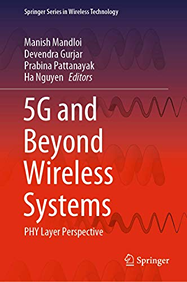5G and Beyond Wireless Systems PHY Layer Perspective
Material type: TextLanguage: English Series: Springer Series In Wireless TechnologyPublication details: Singapore : Springer, c2021 Description: XXIV, 410 p. : illISBN:
TextLanguage: English Series: Springer Series In Wireless TechnologyPublication details: Singapore : Springer, c2021 Description: XXIV, 410 p. : illISBN: - 9789811563928
- 621.384 MAN
| Item type | Current library | Collection | Shelving location | Call number | Copy number | Status | Date due | Barcode |
|---|---|---|---|---|---|---|---|---|
 Reference Collection
Reference Collection
|
Reference Section | Department of Telecommunications Engineering | Reference Section | 621.384 MAN | 2022-23 | Available | 97878 |
About the editors
Dr. Manish Mandloi is an Assistant Professor in the Department of Electronics and Telecommunication Engineering, SVKM’s NMIMS (Deemed to be University) Shirpur Campus, Shirpur, India. He received his B.Tech. in electronics and communications engineering from SASTRA University, Thanjavur, India, in 2011, Master's in telecommunications engineering from Indian Institute of Science Bangalore, India, in 2013, and Ph.D. in electrical engineering from Indian Institute of Technology Indore, India, in 2017. His major areas of research include low-complexity signal processing techniques for massive MIMO communication systems, and simultaneous wireless information and power transfer. He has published several papers in reputed international journals. He received the IEEE Communications Letters exemplary reviewer recognition for the year 2017.
Dr. Devendra S. Gurjar is working as an Assistant Professor in the Department of Electronics and Communication Engineering, National Institute of Technology Silchar, Assam, India. He received the B. Tech. in electronics and communications engineering from Uttar Pradesh Technical University, Lucknow, India, in 2011, the M. Tech. in wireless communications and computing from the Indian Institute of Information Technology Allahabad, India, in 2013, and his Ph.D. in electrical engineering from the Indian Institute of Technology Indore, India, in 2017. He was with the Department of Electrical and Computer Engineering, University of Saskatchewan, Saskatoon, SK, Canada, as a Post-Doctoral Research Fellow. His current research interests include MIMO communication systems, cooperative relaying, device-to-device communications, physical layer security, and simultaneous wireless information and power transfer. He has numerous publications in peer-reviewed journals and international conferences. He is a member of the IEEE Communications Society and the IEEE Vehicular Technology Society.
Dr. Prabina Pattanayak is working at the National Institute of Technology Silchar, Assam, India, as Assistant Professor in the Department of Electronics and Communication Engineering. He has received the B. Tech. in Electronics and Telecommunication engineering in 2007 and M. Tech. in Electronics and Communication Engineering (with specialization in Wireless Communication Technology) in 2012 from Biju Patnaik University of Technology, Odisha, India. He obtained his Ph.D in Electrical Engineering from the Indian Institute of Technology Patna, India, in 2017. He was the recipient of Gold medal for his M.Tech degree. He has also served HCL Technologies Ltd. in the capacity of Lead Engineer from 2007 to 2010. His current research interests include multi-user MIMO, MIMO-OFDM, Massive MIMO communication systems, Soft Computing for various communication areas, Smart Grid Communications etc. He has published several articles in peer-reviewed journals and reputed national and international conferences. He is a member of the IEEE Communications Society, the IEEE Vehicular Technology Society, and the IEEE Information Theory Society.
Prof. Ha H. Nguyen joined the Department of Electrical and Computer Engineering, University of Saskatchewan, Saskatoon, Canada, in 2001, and currently holds the position of NSERC/Cisco Industrial Research Chair in Low-Power Wireless Access for Sensor Networks. He received the B.Eng. degree from the Hanoi University of Technology, Hanoi, Vietnam, in 1995, the M.Eng. degree from the Asian Institute of Technology, Bangkok, Thailand, in 1997, and the Ph.D. degree from the University of Manitoba, Winnipeg, Canada, in 2001. He co-authored the textbook “A First Course in Digital Communications” (published by Cambridge University Press). His current research interests include communication theory, wireless communications, and statistical signal processing. Dr. Nguyen was an Associate Editor of the IEEE TRANSACTIONS ON WIRELESS COMMUNICATIONS from 2007 to 2011 and IEEE WIRELESS COMMUNICATIONS LETTERS from 2011 to 2016. He currently serves as an Associate Editor for the IEEE TRANSACTIONS ON VEHICULAR TECHNOLOGY. He is a Fellow of the Engineering Institute of Canada.
summary:
This book presents the fundamental concepts, recent advancements, and opportunities for future research in various key enabling technologies in next-generation wireless communications. The book serves as a comprehensive source of information in all areas of wireless communications with a particular emphasis on physical (PHY) layer techniques related to 5G wireless systems and beyond. In particular, this book focuses on different emerging techniques that can be adopted in 5G wireless networks. Some of those techniques include massive-MIMO, mm-Wave communications, spectrum sharing, device-to-device (D2D) and vehicular to anything (V2X) communications, radio-frequency (RF) based energy harvesting, and NOMA. Subsequent chapters cover the fundamentals and PHY layer design aspects of different techniques that can be useful for the readers to get familiar with the emerging technologies and their applications.
